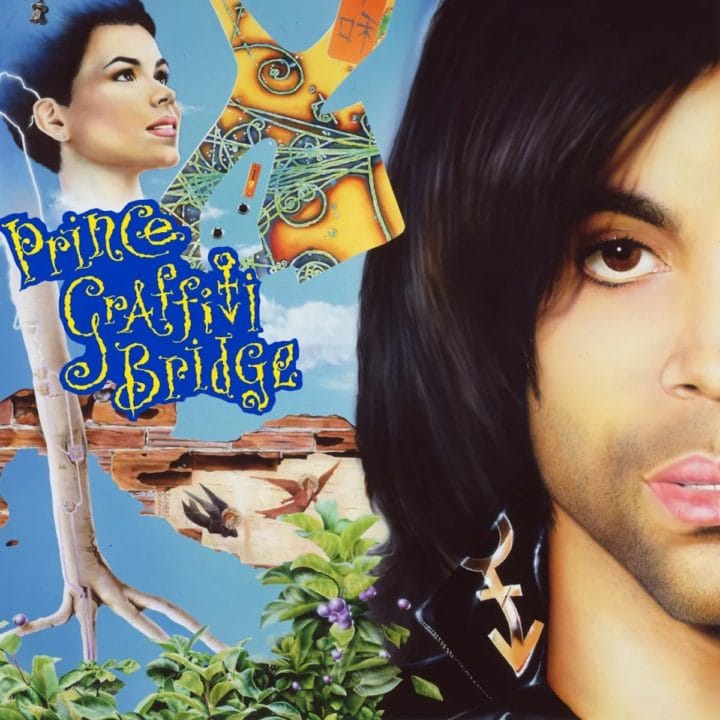
With a run of albums demonstrating his Midas touch behind him, Prince opened up the vault for his 12th studio effort, Graffiti Bridge – by no means his finest, but pivotal in his career…
Words by Beth Simpson
Graffiti Bridge is generally regarded as marking the end of Prince’s ‘imperial phase’, the period during which everything he touched seemed to turn to gold. The film has come to be known as an out-and-out turkey that stank so pungently that, notoriously, it went straight to video in the UK. The accompanying album, though, sandwiched between the inventive Batman soundtrack and the well-regarded Diamonds And Pearls, tends to be forgotten and is no one’s idea of their favourite Prince album. In Matt Thorne’s 2012 biography of the man, the chapter covering this era is entitled ‘What’s Wrong With Graffiti Bridge?’.
Quite a lot if we’re talking about the film. But if we’re concentrating on the soundtrack alone, well, that’s another matter entirely.
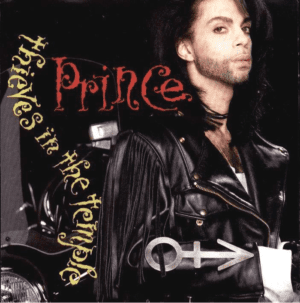
Under The Bridge
In many respects the album was a rounding up exercise for forgotten tracks that had been lying around Paisley Park waiting to find a home. Though the existence of an extensive stockpile of unreleased songs – the so-called ‘vault’ – only became known later in the 90s, this was the first time Prince had dipped into his unreleased stash to complete a new album project. Up until now, he hadn’t needed to. Why would he when he was putting out LPs as strong as Parade and Sign O’ The Times?
The opener Can’t Stop This Feeling I Got dates back to 1982 when it was recorded at home before another version was tried out four years later. We Can Funk (originally, ahem, ‘We Can Fuck’) had been recorded with The Revolution in 1986 but didn’t make the final cut for Parade. Tick, Tick, Bang dates from the Controversy sessions of 1981 and had originally been set aside for girl group protégés Vanity 6 to record before Prince thought better of it. Meanwhile Joy In Repetition had been due to be released on the Crystal Ball triple album in 1987 before that magnum opus was pared down to a double and released as Sign O’ The Times.
Paisley Park Vaults
But why did Prince even need to trawl the vault at this time? A lack of an overall vision for the entire project may well have played a part. From the start, Graffiti Bridge had had a troubled gestation – the movie had changed drastically since Prince had originally envisaged it back in 1987. Back then it wasn’t a sequel to Purple Rain at all, but a completely new story that would have featured Prince as ‘Camille Blue’, and another character Ruthie Washington, who Prince had originally wanted Madonna to play. He had even recorded a Graffiti Bridge soundtrack in 1988, a succinct 10-track record, which, aside from A Question Of U and the title song, had a completely different tracklist.
But Madonna turned down the role and it soon became clear that post-Under The Cherry Moon Warners were only interested in funding another Prince movie project if it was pitched as a sequel to Purple Rain. Also around this time Prince rekindled his friendship with Morris Day and started writing material for the reformed Time. Plus he’d also signed Mavis Staples and George Clinton to Paisley Park Records so why not include them on an accompanying soundtrack too?
Indeed, this is the first time a Prince album had contained tracks fronted by other artists, though of course he’d written and produced them. There were four songs by The Time, Prince’s celluloid rivals. Release It and The Latest Fashion are both the sort of directionless funk workouts that Prince could write in his sleep, whereas Shake is a kind of old-skool rock’n’roll dance number which purloins the keyboard refrain from 96 Tears. The Mavis Staples-featuring Melody Cool sees her adopt the titular persona, but it feels underdeveloped and repetitive, as if Prince had got bored halfway through writing it.
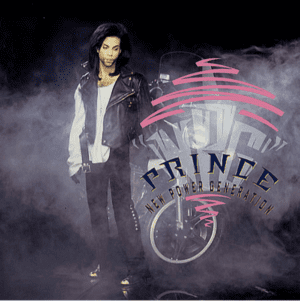
Hidden Gems
Elsewhere there’s Tevin Campbell, the New Jack Swing child star whose androgynous voice suits Round And Round’s minimal funk to a tee. More puzzling is the use of George Clinton on We Can Funk. You’d come expecting a grand funk summit between two of its greatest icons, but you can barely hear Clinton’s vocals in the mix. It’s as if he’s hardly there.
Also on the debit column there is the title track, a somewhat unlikely step towards musical theatre – you could imagine the cast of a Broadway musical production giving their all to the rather trite lines about how “everyone’s looking for love” and “everything’s gonna be alright”.
However Graffiti Bridge does contain a number of gems that stand comparison with some of Prince’s greatest work. The Question Of U is a wonderfully languorous piece with syncopated handclaps and a guitar solo that confirms that Prince was one of the best guitarists in the world (as well as everything else).
Bold Generation
Then there was Elephants & Flowers, a gospel-influenced slice of Prince pop which contains the brilliantly odd refrain “there will be peace for those who love God a lot”. Joy In Repetition is another of those little gems that tend to get forgotten about, with a halting half-spoken, half-sung vocal and another eye-screwingly impressive guitar solo from the man himself.
Perhaps best of all is Still Would Stand All Time, a wonderfully woozy-sounding, gospel-influenced ballad which had been first recorded in 1988 and had been considered for the Batman soundtrack, before being reworked with backing vocals from The Time for Graffiti Bridge. It’s another one that often gets overlooked, but in the pantheon of Prince ballads it’s up there with Parade’s heartbreaking finale Sometimes It Snows In April.
The album’s lead single, Thieves In The Temple, was the last to be recorded for the project, in February 1990. Though not at the same level as predecessors such as Kiss or Alphabet Street, its nonetheless one of the more memorable moments from the album, and rightly turns up on most hit compilations. Its follow up, New Power Generation (originally titled ‘Bold Generation’), would provide us with a sneak preview of his next ensemble. The NPG itself hadn’t been fully assembled at the time of Graffiti Bridge’s release though guitarist Levi Seacer Jr had been playing with Prince since 1987, drummer Michael Bland had been in the band for a year and keyboardist Rosie Gaines plays on several Graffiti Bridge tracks.
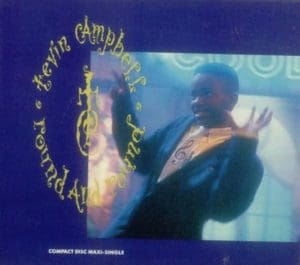
New Jack Swing
Lyrically, New Power Generation is as close to a manifesto as Prince has ever drawn up. He had used the phrase before – in a preamble to the Lovesexy LP track Eye No, Ingrid Chavez had intoned, “Welcome to the New Power Generation”. But here Prince fleshes out the concept with a two-part exercise in what could be described as militant funk, as he dismisses his opponents’ “old fashioned music, your old ideas/ We’re sick and tired of you telling us what to do”.
There’s an undercurrent of this sort of abrasiveness, this snippiness, in Graffiti Bridge, as he admitted in an interview with Rolling Stone in 1990: “I feel good most of the time, and I like to express that by writing from joy. I still do write from anger sometimes, like in Thieves In The Temple. But I don’t like to. It’s not a place to live.”
Of course, this feeds into the plot of the movie – essentially The Kid’s band versus The Time – but on another level you wonder whether Prince himself was feeling the heat of the changing musical climate. We already know that he regarded hip-hop as a threat (see Dead On It from The Black Album) and he was aware that New Jack Swing, the dominant pop style of late 80s/early 90, was largely the work of ex-Time members Jimmy Jam and Terry Lewis. After leading the pack – creatively and critically – for so long, he knew he had competition and would have to raise his game accordingly.
The Pop Picasso
Graffiti Bridge, then, is not short of highlights. But at an overlong 68 minutes running time, it is probably the first – but certainly not the last – example of a Prince album to suffer from CD bloat. Whereas the double set Sign O’ The Times seemed to fly by, Graffiti Bridge drags towards the end and you could make a convincing case for reducing it to a killer single album.
It’s worth pointing out that critics were not unduly harsh at the time. Indeed, many were exalting in their praise. Greg Sandow in Entertainment Weekly claimed that Graffiti Bridge “seems to be a masterpiece”. Rolling Stone’s Paul Evans declared it as “a 17-song tour-de-force that reclaims Prince’s rare stature as a pop Picasso”. The Washington Post’s Geoffrey Hines could barely contain his glee, calling Graffiti Bridge “one of the most erotic, sexually stimulating albums in pop music history.”
Sexually Stimulating
There was an element, it must be said, of not wanting to be the first courtier to stop applauding to these contemporary reviews; as this point Prince had been feasting on critical hosannas for over half a decade. As time went by, more critics began to swoop. John Freeland, writing in The Quietus in 2012, described it as “horrible”. Robert Christgau, the self-styled ‘dean’ of US rock critics, meanwhile, moaned that “half the music isn’t really his, and the other half is overly subtle if not rehashed or just weak.”
Not that Prince has ever had any time for critics. “There’s nothing a critic can tell me that I can learn from. If they were musicians maybe, but I hate reading about what some guy sitting at a desk thinks about me,” Prince told Rolling Stone around this time. “Now, on Graffiti Bridge they’re saying I’m back and more traditional. Well, Thieves In The Temple and Tick, Tick, Bang don’t sound like nothing I’ve ever done before.”
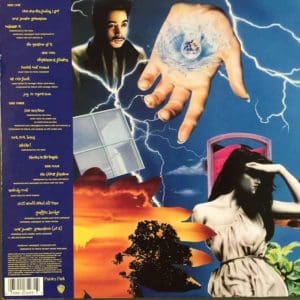
A New Power
He would have been more stung by the album’s commercial performance. The only major territory in which it topped the charts was the UK, where – not coincidentally – the film didn’t get a cinema release. It’s clear that the hammering that Graffiti Bridge the movie received from film critics affected sales of the album. In the States it struggled to No.6 and a mere 500,000 sales (by contrast the Batman LP had shifted over two million; Purple Rain to date has sold over 13 million).
This must have hurt a man of Prince’s ego and Graffiti Bridge represents a turning point in his career. Never again would he be diverted away from his core concern – music – by cinema. It also marks the start of a new collaborative phase in his career. Having made the last three records largely on his own, he was clearly warming to the idea of having a full-time band behind him once again. His next project would see the return to core values, a shared credit with a backing group and would end up becoming his most fondly regarded and, arguably, best album of the decade.
The Songs
Can’t Stop This Feeling I Got
Graffiti Bridge kicks off with Prince speaking to his father: “Dear dad, things didn’t quite turn out the way I wanted them to/ Sometimes I feel like I’m going to explode”. Followed by, yes, an explosion. That’s the unlikely intro to a breezy pop track that’s a close cousin of Play In The Sunshine off Sign O’ The Times.
New Power Generation Part I
The most immediate track on the album was released as the third single in October 1990 but could only reach US No.64. The bridge lyrics “making love and music are the only thing worth fighting for” could neatly summarise Prince’s whole worldview. Despite it essentially christening his new group, it’s a track that was never played live by Prince after 1991.
Release It
A spoken-word intro by Morris Day and a squally sax solo ushers us into the first appearance by The Time on Graffiti Bridge. Morris gives it his all, asking his band members “whose crib is this? (My crib!). Whose wine you drinkin’? (Mine!)”. But despite his best efforts, there’s no disguising that this is Prince going through the motions, a funk jam that doesn’t go anywhere, that could have easily been cut.
The Question Of U
Another track that had spent a long time in the vault before finding a home, The Question Of U builds from a lolloping blues rhythm, adding layers of handclaps, an outstanding guitar solo, gospel vocals and even a touch of harpsichord to become a thing of beauty. At one point it was mooted as a possible single release, but was eventually cancelled.
Elephants & Flowers
Recorded by Prince and Prince alone on a day off from the Lovesexy tour in 1988, Elephants & Flowers is one of those tracks that is a testament to the man’s casual genius. It’s minor perhaps, with lyrics that don’t stand close scrutiny, but the hip-grinding guitar riff, gospel backing vocals and air of untrammelled joy make it one of the keepers on Graffiti Bridge.
Round And Round
Tevin Campbell’s feature on Graffiti Bridge is a decent enough song, but arguably doesn’t quite fit on the album. Maybe that’s because the finished version was remixed by DJ Junior Vasquez and thus lost some of its Prince-iness along the way. It did become a hit, though, reaching Billboard No.12 in September 1990.
We Can Funk
Tried out as ‘We Can Fuck’ as long ago as 1983. Allegedly, it’s a duet with George Clinton, though you can hardly hear Dr Funkenstein in the mix. Incidentally, Prince reused one of its synth lines when he wrote Martika’s Kitchen, the title track of the singer’s 1991 album.
Joy In Repetition
Seguing straight from We Can Funk, this is a strung-out, percussion-heavy track recorded by Prince alone back in 1986, except from backing vocals from Susannah Melvoin. It’s another that was on the original tracklisting for Crystal Ball until it was pared down to Sign O’ The Times. He half-speaks, half-sings and unleashes another incredible guitar solo, before the track curls up inside itself and segues straight into…
Love Machine
Not The Miracles hit, but another Time funk workout. Interest is raised by the vocal interplay between Morris Day and Elisa Fiorillo – her first appearance on a Prince record – and those forced laugh ‘huh huh huh huh huh’ backing vocals. Also appearing is Candy Dulfer, the sax player best known for the hit Lily Was Here, who would join the NPG as a full-time member later in the 1990s.
Tick, Tick, Bang
Another relic dug up from the early 1980s, from the sessions for Controversy to be exact. With squally guitar, scratchy noises, synth bangs and crashes, it’s one of those tracks where he throws all sorts of unlikely ingredients into the pot but still emerges with something that is utterly compelling.
Shake!
The best of the four Time tracks on the album is a 1990s update on those rock’n’roll dance records from four decades previously. It’s featured in the film and indeed it’s worth checking out the excerpt from the movie on YouTube, which sees Morris Day and the band perform the song on a stage surrounded by burning flames.
Thieves In The Temple
In contrast, the lead single is one of the darker moments from the album – it’s a rare moment in which Prince confesses to loneliness (“my only friend is you”). There are Oriental touches on the synths, plus a harmonica sample from The Chambers Brothers 1967 track I Can’t Stand It and a stop-start rhythm that makes it unusual for a Prince single. That didn’t stop it reaching No.7 in the UK and No.6 in the US.
The Latest Fashion
Another of the Time tracks that arguably could had been kept off the tracklist in order to create a stronger album. The opening “Go Morris! Go Morris!” chants are probably the most memorable moment of what is a duet between Day and Prince that doesn’t go anywhere.
Melody Cool
Mavis Staples’ opening speech about “crossing bridges” and “trials and tribulations, heartache and pain” is, of course, a nod to her role in the Civil Rights struggle. A pity that the track doesn’t really go anywhere after that, the lyrics largely consisting of “they call me Melody Cool” repeated over and over.
Still Would Stand All Time
The highlight of the LP arrives late, a beautiful ballad that leans heavily into gospel, with subtle orchestration and The Time and The Steeles all providing backing vocals. This had been considered for the Batman soundtrack but was replaced by Scandalous and eventually found a natural home as the pivotal moment in the movie’s plot, with The Kid winning his battle with a ballad, much to The Time’s chagrin.
Graffiti Bridge
Not one of his finest moments, it must be said. With its trite lyrics, the title track wouldn’t have sounded out of place in High School Musical. Mavis Staples adds some vocal heft, as do Tevin Campbell and Sheila E, but nothing can rescue what’s one of the few Prince tracks that can only be described as embarrassing.
New Power Generation Part II
Graffiti Bridge ends with a reprise of this, which adds a rap from TC Ellis and an instrumental run out. The album ends with the sound of running water and a drawled voice (Prince’s) intoning “the New Power Generation have just taken control”.
For more on Prince click here
Read More: Essential Prince In The 90s
The post Album Insight: Prince – Graffiti Bridge appeared first on Classic Pop Magazine.
